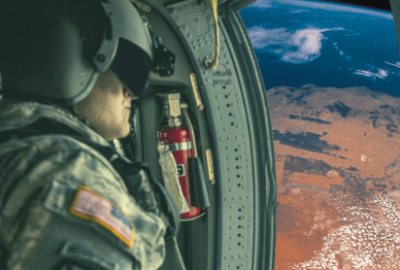

The Air Force needs to keep the Space Force in its organization while also letting it build its own culture.
The Air Force’s top military official says creating the Space Force is a delicate balancing act as officials grapple with how to nest the new service within the larger Air Force organization.
“How do we build a service on the foundation of trust and confidence focused on integrated joint warfighting, but at the same time allow the Space Force to develop its own service culture?” Air Force Chief of Staff Gen. David Goldfein said Monday at a Center for a New American Security event in Washington. “We could hug it too close and slow it down, or we could allow space to get separated to every little separate service. There’s a sweet spot we’ve got to find, and we are driving that.”
Goldfein said his task is to ensure the Space Force and the Air Force do not grow too far apart as the Space Force takes a similar position of the Marine Corps within the Navy.
The Space Force has a unique role in that its mission is inherently joint. Every service will use U.S. space assets and call on the Space Force to conduct operations.
“The question is: ‘What are we building?’” Goldfein said. “Did we build two services on the foundation of trust, competence and focus on integrated joint warfighting? Or did we allow others to make it some kind of divisive split? Is this a marriage or a divorce? This is a marriage and we’ve got to do this well.”
Goldfein said that since a new service hasn’t been created in more than 70 years that he is basically writing his own template.
He said as the services grow together there will be parts of the Space Force that will be conducted primarily by the Air Force, but as the individual elements of the Space Force are stood up those responsibilities will shift.
Goldfein also noted that he would be open to meeting with the other military services to rehash each of their responsibilities in a new environment where joint warfighting is more important than ever. He said he would consider attending another Key West Agreement of 1948, which defined roles and responsibilities of the services after the creation of the Air Force.
The Air Force secretary must deliver a plan to Congress by the end of the week on how it will set up the Space Force.
Internally, the new service is still wrestling with how it will function as a service.
“This is a huge opportunity. We have the opportunity to create a warfighting service from scratch,” Maj. Gen. John Shaw, leader of Space Force’s Space Operations Command said Jan. 10. “I’ve been telling the team, ‘Don’t think about a warfighting service for the next decade. Create a warfighting service for the 22nd century. What is warfighting going to look like at the end of this century and into the next?’”
Shaw said while the Space Force needs to carve out its own niche in the military, space connects all of the services. He likened the force to the element carbon in that it bonds to everything. The Space Force will help be and protect the glue between the military services for things like position, navigation and timing.
Shaw said the Space Force needs to think about doctrine, training and fighting differently as well.
“The Air Force is mostly expeditionary focused and needs to be,” Shaw said. “We train and we move to the fight. That’s how the Air Force works. What does warfighting for space look like? There’s not a lot of movement going on. It’s happening 24/7, 365 days a year and it’s happening in home station. We call it employed in place. It’s not even deployed in place because that presumes you move somewhere.”
Copyright © 2024 Federal News Network. All rights reserved. This website is not intended for users located within the European Economic Area.
Scott Maucione is a defense reporter for Federal News Network and reports on human capital, workforce and the Defense Department at-large.
Follow @smaucioneWFED

